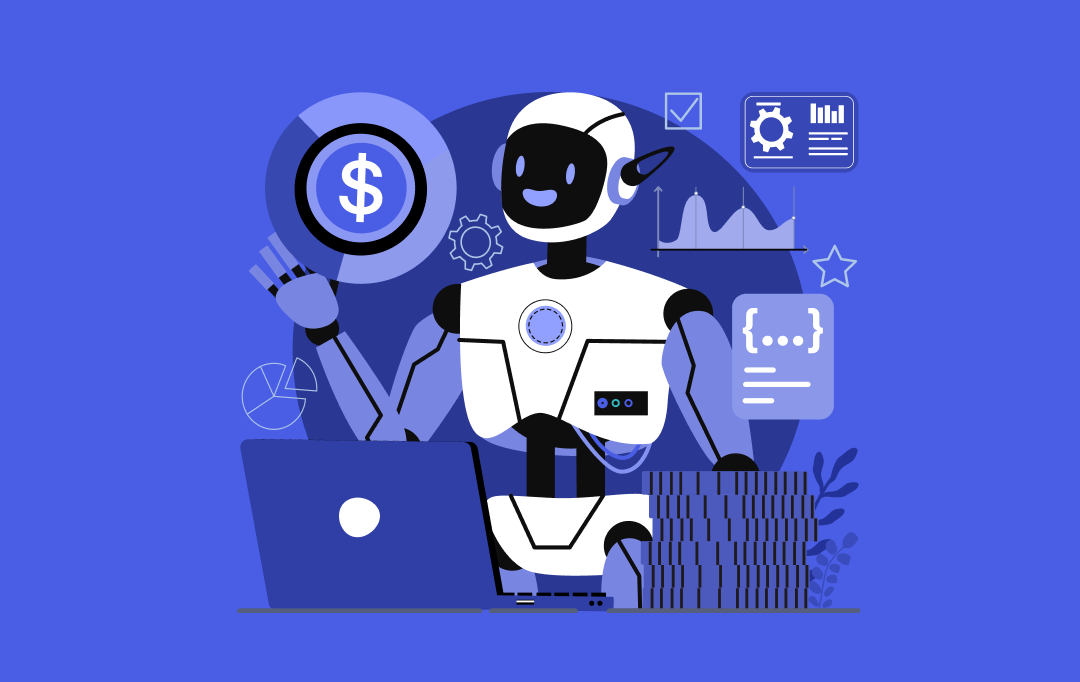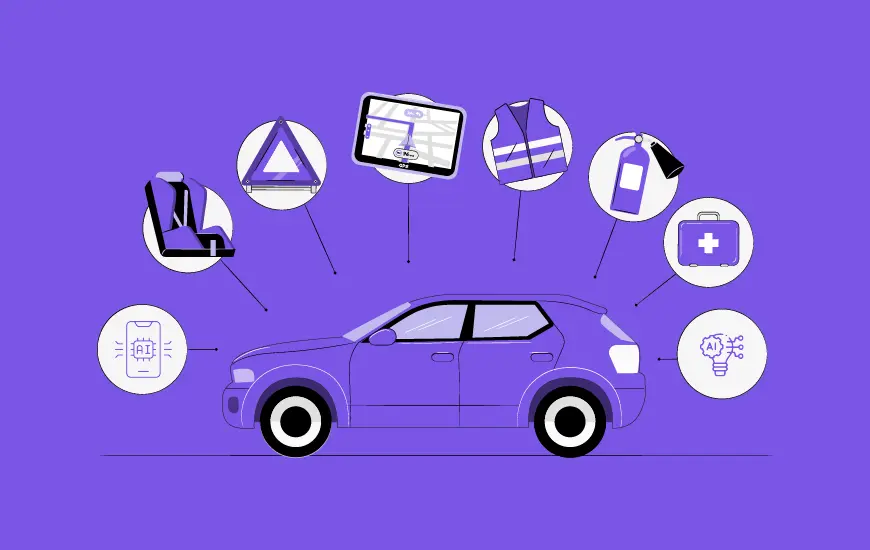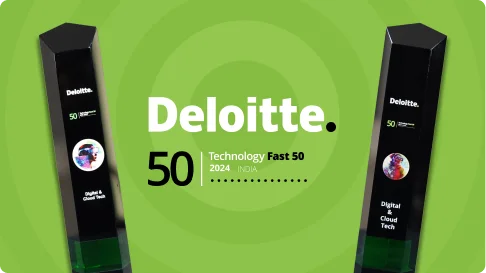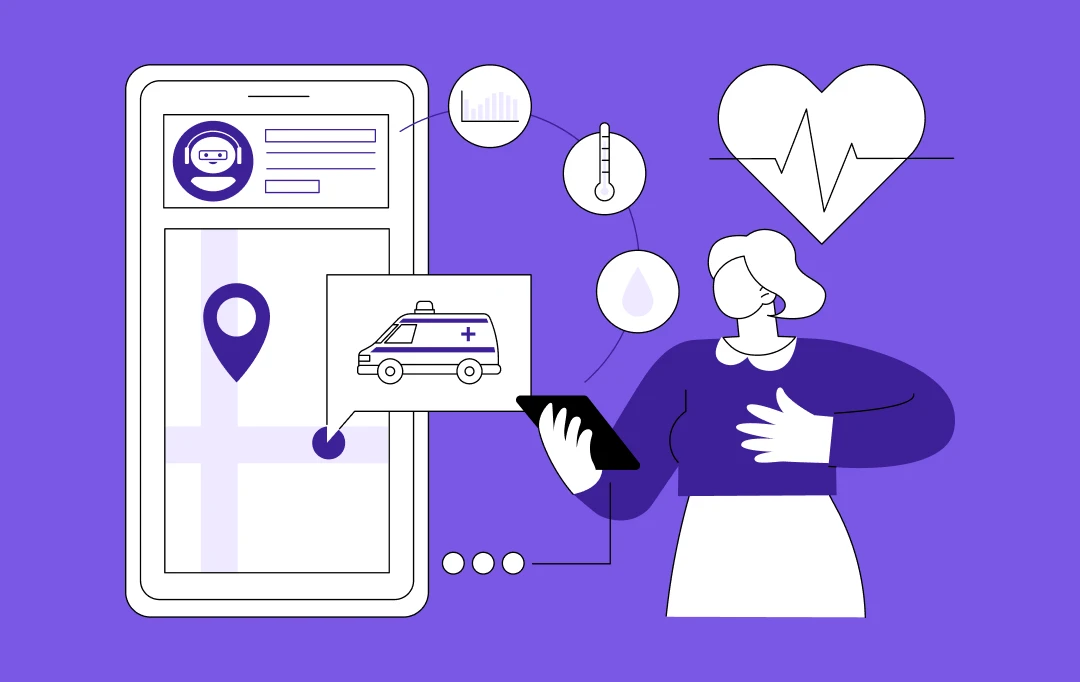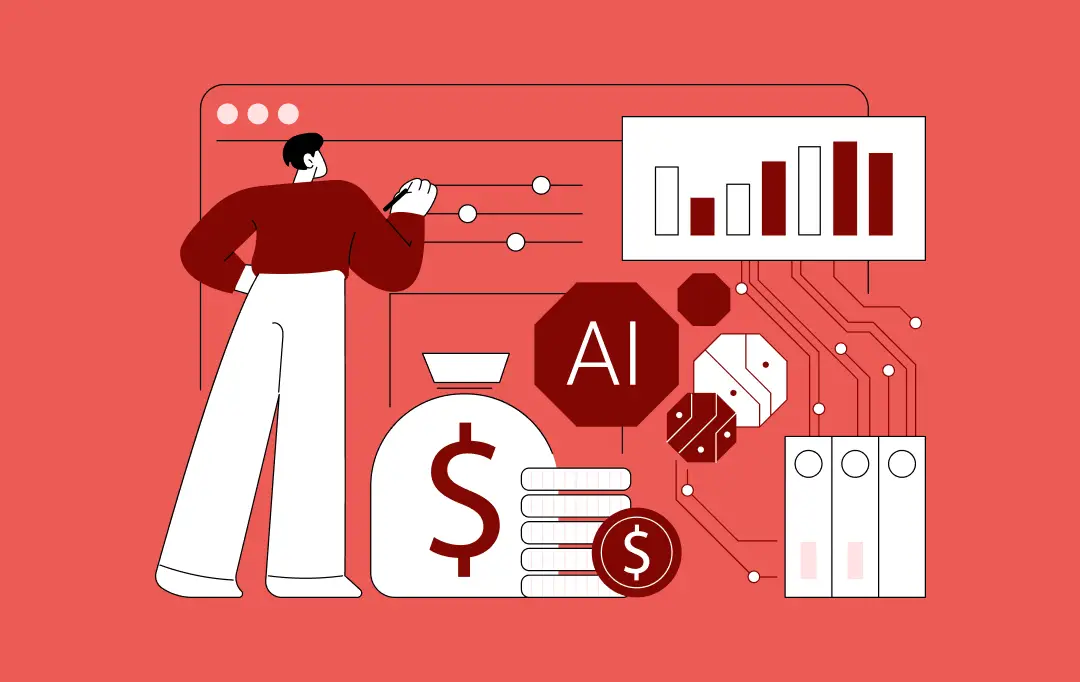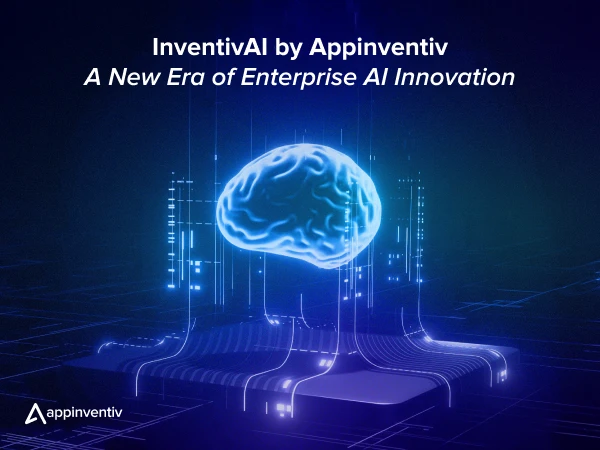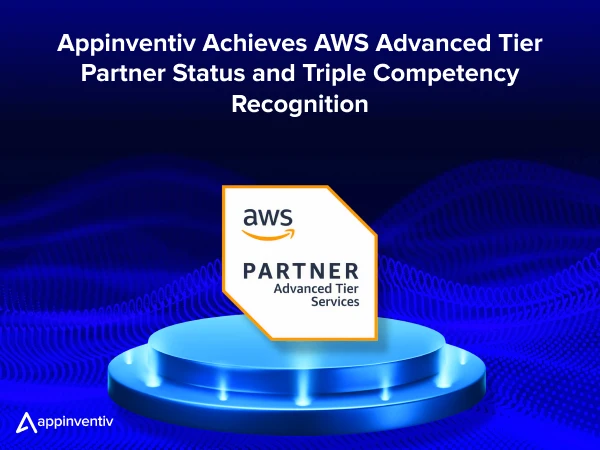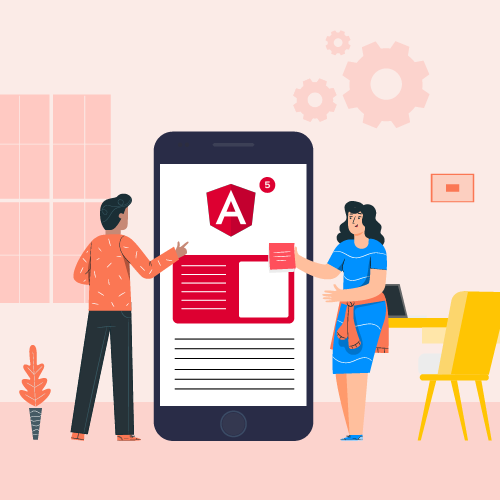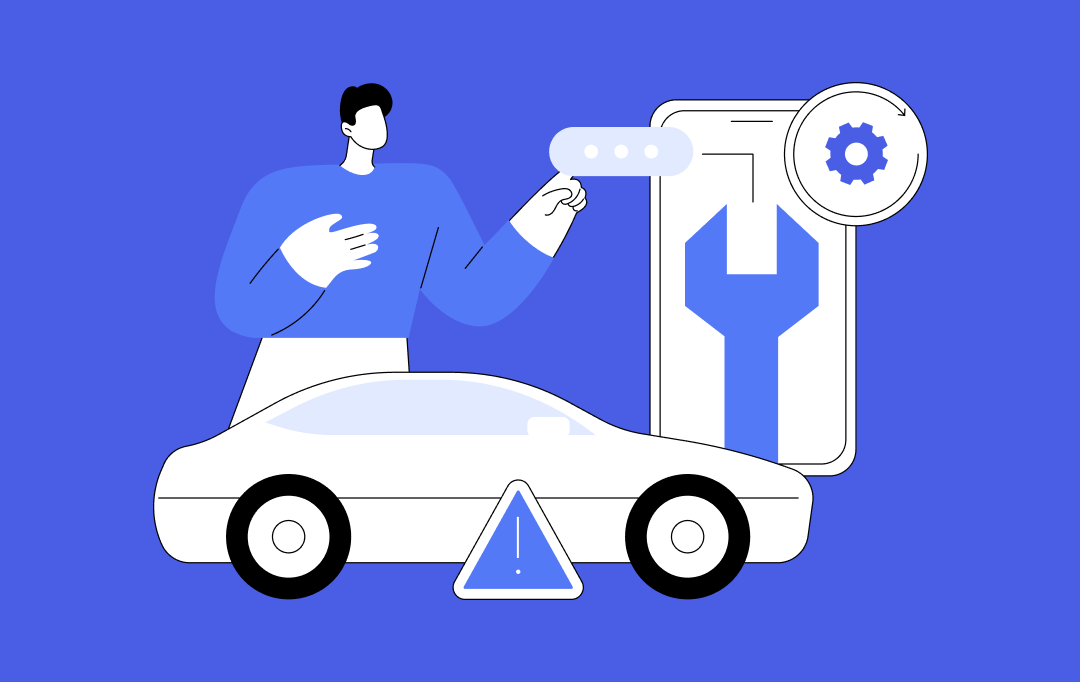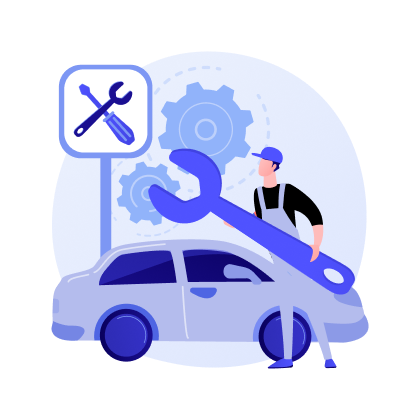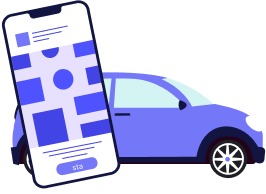- Market Size & Forecast: Automotive Repair and Maintenance Service
- How Vehicle Maintenance Apps Work
- How to Build a Vehicle Maintenance App
- Research the Vehicle Maintenance Market & User Needs
- Define Must-Have Features for Vehicle Maintenance
- Choose the Right Tech Stack
- Design a User-Friendly Interface
- Develop an MVP Focused on Core Vehicle Maintenance Features
- Test for Performance, Security & Functionality
- Deploy & Optimize for App Store Visibility
- Provide Regular Updates & Long-Term Support
- Basic Features That Make a Car Maintenance App Stand Out
- Advanced Features of a Vehicle Maintenance App
- Vehicle Maintenance App Use Cases With Real-Life Examples
- UPS’ IoT-Based Fleet Optimization
- Tesla’s Use of Digital Twin for Predictive Vehicle Maintenance
- GM’s AI-Powered Predictive Maintenance
- Mercedes-Benz’s Utilization of AI Assistants for Vehicle Maintenance
- Cost to Build a Vehicle Maintenance App
- How to Monetize a Vehicle Maintenance App
- Value-Added Services
- Marketplace Model
- Lead Generation Model
- Challenges to Build a Vehicle Maintenance App and Solutions to Overcome Those
- Future Trends in the Automotive Industry
- Build a Powerful & Scalable Vehicle Maintenance App with Appinventiv
- FAQs
With cutting-edge mobile app technology making waves in the automotive world, our cars have become more interactive than ever before. Your vehicle can now send you text messages or start a conversation when it needs an oil change or has a battery issue. That’s the real value a vehicle maintenance app brings—it eliminates guesswork, helps you stay on top of repairs, and protects you from costly breakdowns.
With 70% of drivers preferring digital tools for vehicle upkeep, the demand for smart maintenance solutions is growing fast. Companies like Tesla have already integrated remote diagnostics and service scheduling into their apps, setting new standards for convenience.
For automotive businesses, this shift toward digital solutions presents a massive opportunity. A vehicle maintenance app enhances customer convenience and builds long-term brand loyalty. By offering features like automated service reminders, real-time diagnostics, and in-app scheduling, businesses can keep customers engaged while reducing no-shows and missed services.
With more drivers expecting seamless, tech-driven experiences, investing in a smart maintenance app isn’t just a trend—it’s a strategic move to stay ahead in the evolving automotive industry.
So, how do you create one? This guide’ll break down must-have features, the development process, and costs, helping you build an app that keeps vehicles running smoothly while driving business growth.
Market Size & Forecast: Automotive Repair and Maintenance Service
Additionally, as per a report by Mordor Intelligence, the global automotive repair and maintenance market is projected to reach $1.06 trillion by 2030 during the forecast period 2025-2030.
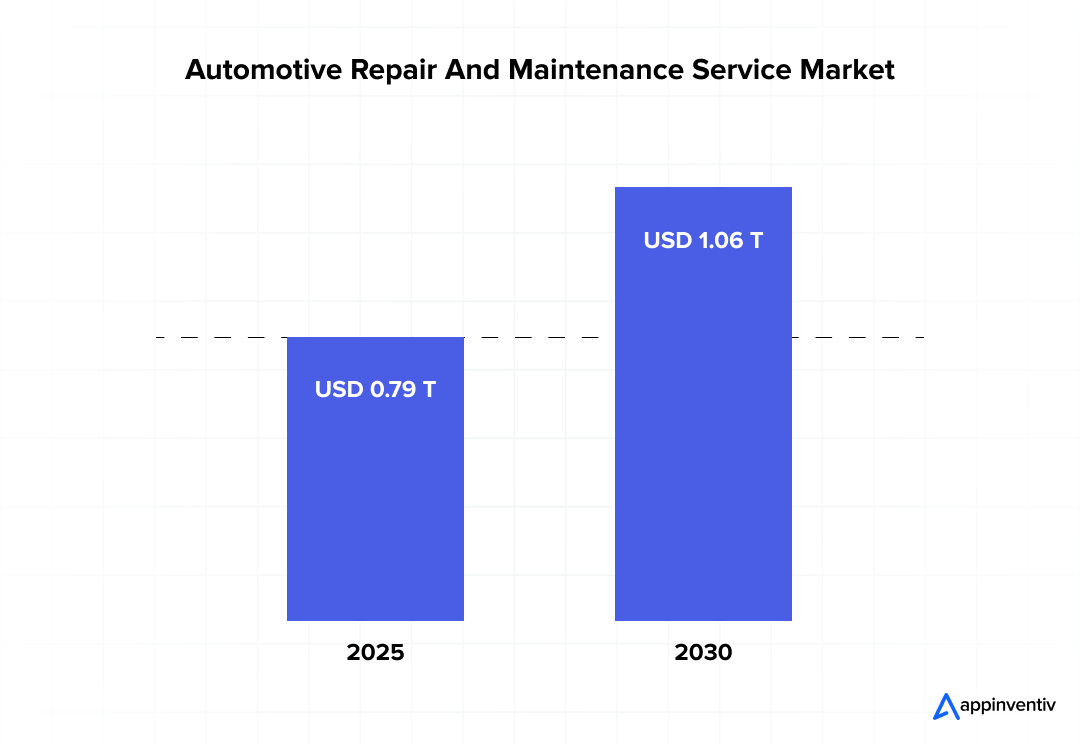
This growth is driven by increasing vehicle ownership, advancements in AI-driven diagnostics, and the rising adoption of connected car technologies. Automakers like Tesla and BMW have already incorporated predictive maintenance and remote diagnostics into their apps, setting new benchmarks for convenience and efficiency.
How Vehicle Maintenance Apps Work
A vehicle maintenance app is a smart assistant, helping car owners stay on top of servicing, repairs, and diagnostics. These apps monitor performance, detect issues early, and send real-time alerts by integrating with a vehicle’s onboard diagnostics (OBD-II) system or IoT sensors. Users can track service history, receive maintenance reminders, book appointments, and even get repair cost estimates.
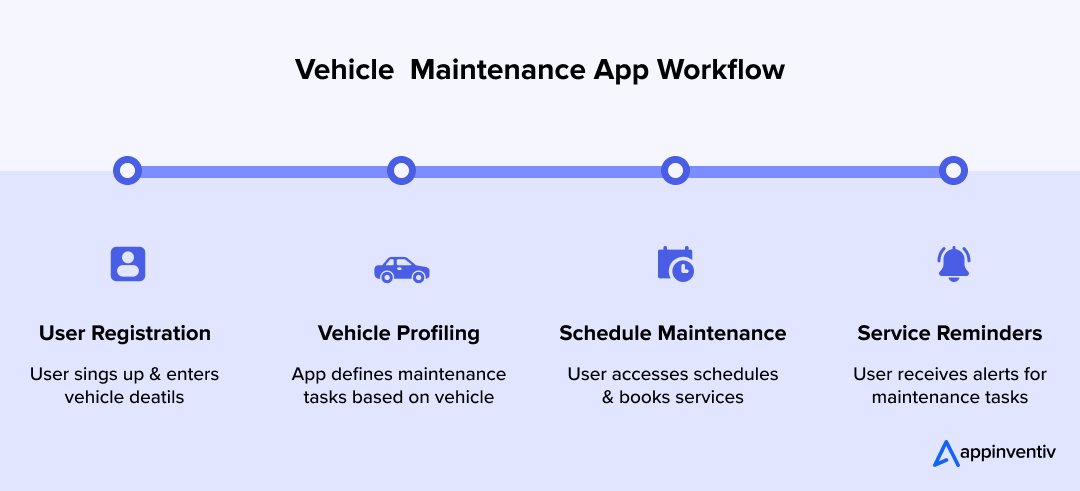
Many apps also include GPS-based features to locate nearby mechanics, fuel stations, or emergency roadside assistance, making vehicle management seamless and hassle-free. The demand for digital vehicle maintenance solutions is growing rapidly as technology transforms the automotive industry.
How to Build a Vehicle Maintenance App
Building a vehicle maintenance app requires careful planning, the right technology, and a seamless user experience. Here’s a step-by-step process to build a vehicle maintenance app:
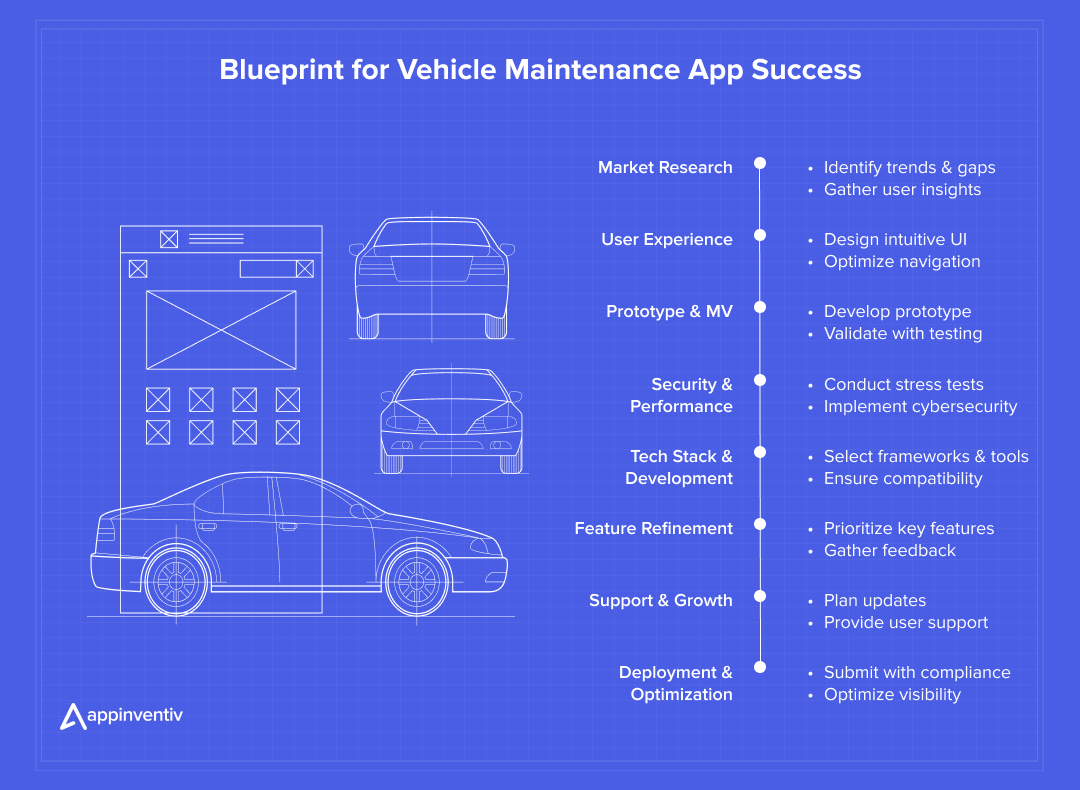
Research the Vehicle Maintenance Market & User Needs
Start by identifying your target users, whether they are individual car owners, fleet managers, or auto service centers. Analyze competitors to understand industry trends, customer pain points, and must-have features before starting with vehicle maintenance app development.
This research will help define your app’s unique value proposition and competitive edge. A well-researched foundation ensures your app meets real-world demands and attracts a loyal user base.
Define Must-Have Features for Vehicle Maintenance
List essential features such as service reminders, vehicle diagnostics, repair tracking, fuel tracking, and emergency assistance. Integrate real-time monitoring with IoT and OBD-II devices to enhance vehicle performance insights.
Add features like multi-vehicle support, push notifications, and service history tracking for a seamless experience. AI-powered predictive maintenance can further improve reliability and user engagement.
Choose the Right Tech Stack
Select a frontend framework like React Native (for cross-platform apps) or Swift/Kotlin (for native apps). Use Node.js or Python for backend development and databases like MongoDB or PostgreSQL for secure data management. Integrate APIs for GPS tracking, notifications, and payment processing. Ensuring scalability from the start will allow your app to support growing user demands without performance issues.
Design a User-Friendly Interface
Develop a clean, intuitive, and mobile-friendly UI/UX that makes tracking vehicle maintenance effortless. Ensure quick access to critical features like service scheduling, checking diagnostics, or finding nearby repair shops.
Implement dark mode, voice commands, and customizable dashboards for an enhanced user experience. A well-designed interface can improve user retention and engagement.
Develop an MVP Focused on Core Vehicle Maintenance Features
Start with key functionalities like vehicle profile setup, service tracking, automated reminders, and emergency contacts. Launch a beta version to gather user feedback and refine features before a full-scale release.
Focusing on an MVP allows you to validate your idea, reduce costs, and make data-driven improvements. It also helps in attracting early adopters and investors.
Test for Performance, Security & Functionality
Perform thorough functional, security, and compliance testing to ensure seamless performance. Validate service tracking, automated reminders, and diagnostics while optimizing speed and stability. Encrypt data, secure APIs, and comply with GDPR, CCPA, and ISO 27001 to protect user information.
Test across devices and in-car systems for compatibility, and align with ISO 26262, SAE J3061, and UNECE WP.29 to meet automotive safety and cybersecurity standards.
Also Read: The Mobile App Testing Strategies that Appinventiv Follows
Deploy & Optimize for App Store Visibility
Publish the app on Google Play Store and Apple App Store, optimizing it for App Store Optimization (ASO) to maximize visibility. Conduct a soft launch to collect feedback and fine-tune performance before the full rollout.
Promote through social media, auto service partnerships, and referral programs to gain traction. A strategic launch ensures higher downloads and a competitive edge.
Provide Regular Updates & Long-Term Support
Continuously monitor and update the app with new features, security patches, and AI-driven enhancements. Monitor user analytics and feedback to improve functionality and eliminate pain points. Provide customer support, chatbot assistance, and tutorial videos to enhance the user experience.
Long-term success relies on innovation, adapting to new automotive trends, and keeping users engaged with value-driven updates.
Basic Features That Make a Car Maintenance App Stand Out
The right features in a vehicle maintenance app ensure proactive upkeep, streamline repairs, and enhance overall vehicle longevity. Let’s look at some key features that make your app stand out from the competition.
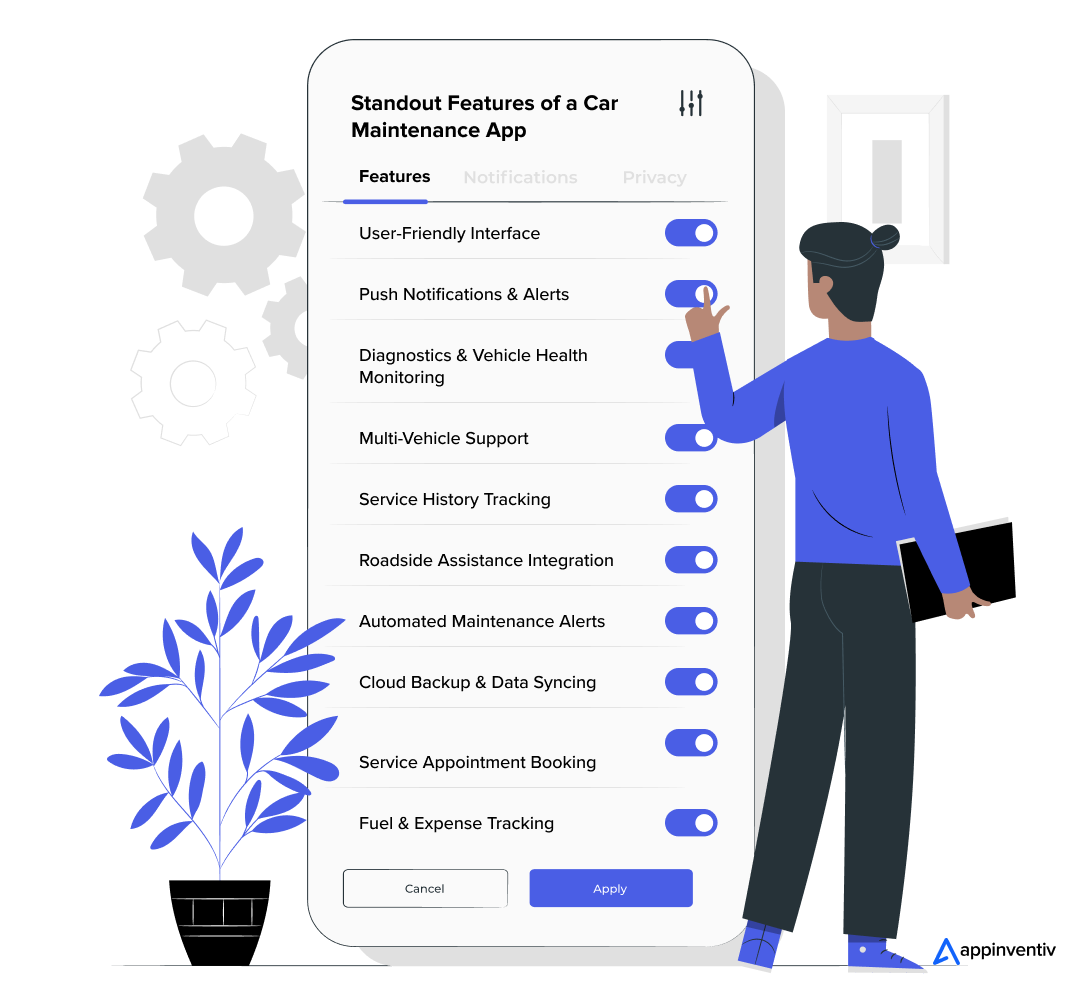
- User-Friendly Interface: Offers an intuitive dashboard with easy access to vehicle details and reports.
- Push Notifications & Alerts: Sends timely updates on due maintenance, insurance renewals, and registrations.
- Diagnostics & Vehicle Health Monitoring: Integrates with OBD-II scanners to detect and display fault codes.
- Multi-Vehicle Support: Allows users to manage maintenance records for multiple vehicles. It is ideal for families, businesses, or fleet owners tracking different service schedules.
- Service History Tracking: Logs past maintenance records, including service dates, costs, and performed services. Helps users track expenses and maintain a well-documented vehicle history.
- Roadside Assistance Integration: Connects users with towing and emergency repair services when needed. Ensures quick help in case of breakdowns, flat tires, or other emergencies.
- Automated Maintenance Alerts: Sends reminders for oil changes, tire rotations, and scheduled servicing. Reduces the risk of missing critical maintenance and prolongs vehicle life.
- Cloud Backup & Data Syncing: Saves maintenance records securely and syncs across multiple devices. Ensures users can access their vehicle history anytime, from any device.
- Service Appointment Booking: Enables users to schedule maintenance visits with nearby auto repair shops. Displays available slots, estimated costs, and appointment confirmations.
- Fuel & Expense Tracking: Tracks fuel usage and vehicle-related expenses for better cost management. Helps users optimize fuel efficiency and keep track of their budget.
Advanced Features of a Vehicle Maintenance App
Incorporating advanced features elevates a car maintenance app from a simple tracker to a smart, data-driven solution. Here’s how implementing advanced features impacts the overall performance of an auto maintenance app.
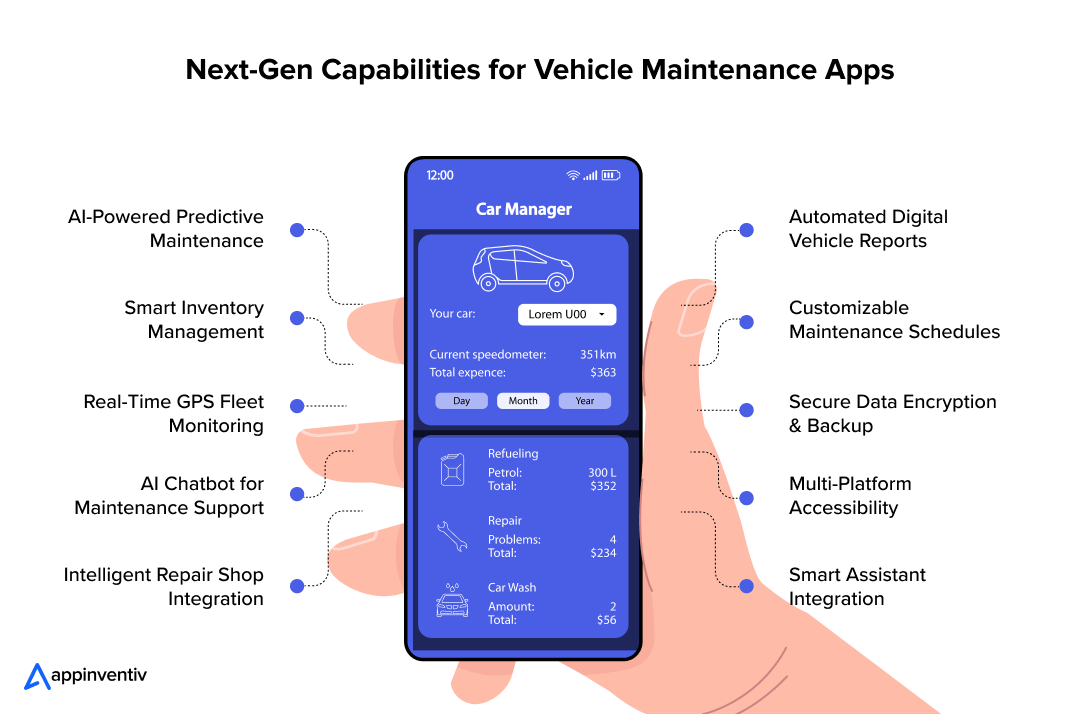
- AI-Powered Predictive Maintenance: Leverages machine learning to detect potential vehicle issues before they arise.
- Smart Inventory Management: Automates tracking of spare parts and supplies for optimized fleet and repair shop operations.
- Real-Time GPS Fleet Monitoring: Provides insights on vehicle location, fuel efficiency, and overall performance.
- AI Chatbot for Maintenance Support: Delivers instant assistance for diagnostics, service reminders, and troubleshooting.
- Intelligent Repair Shop Integration: Connects users with local mechanics, offering real-time service availability and pricing.
- Automated Digital Vehicle Reports: Analyze performance trends and maintenance expenses for data-driven decision-making.
- Customizable Maintenance Schedules: Adapts service reminders based on driving behavior and vehicle usage patterns.
- Secure Data Encryption & Backup: Advanced encryption protocols protect vehicle and user data.
- Multi-Platform Accessibility: Seamlessly integrates across iOS, Android, and web-based interfaces.
- Smart Assistant Integration: Enables voice-activated maintenance updates via Alexa, Google Assistant, or Siri.
Vehicle Maintenance App Use Cases With Real-Life Examples
Leading automotive and fleet management companies leverage advanced technologies like IoT, AI, and digital twins to enhance vehicle performance, optimize maintenance, and reduce operational costs. Below are some top use cases and real-life examples of how these companies implement these innovations.
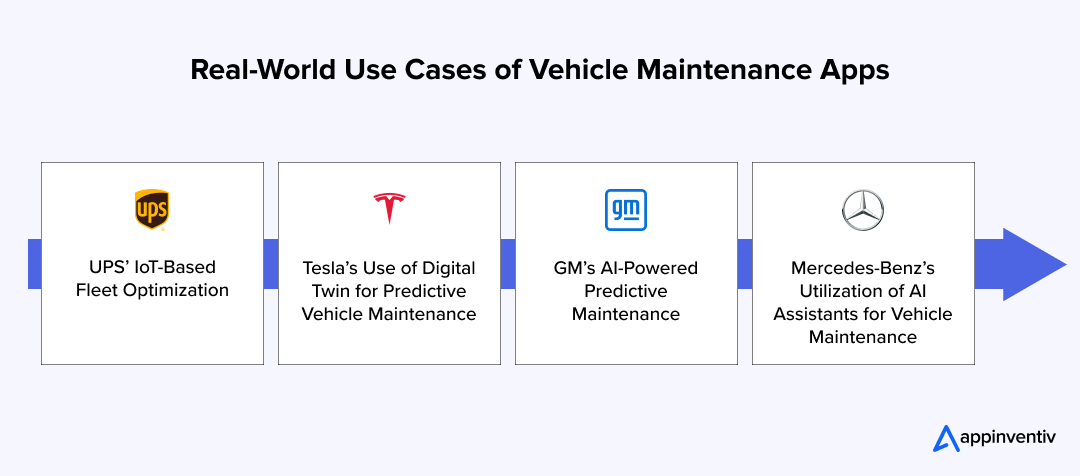
UPS’ IoT-Based Fleet Optimization
IoT-driven fleet management solutions monitor vehicle health, fuel efficiency, and driver behavior. By leveraging data analytics, these systems help fleet operators optimize routes, cut operational expenses, and boost overall efficiency.
UPS utilizes its ORION (On-Road Integrated Optimization and Navigation) system, integrating IoT sensors and AI to track vehicle diagnostics. It also anticipates maintenance needs and enhances route efficiency, leading to significant fuel savings and reduced carbon emissions.
Tesla’s Use of Digital Twin for Predictive Vehicle Maintenance
Digital twin technology in automotive replicates a vehicle’s performance in a virtual environment, enabling real-time issue detection and predictive maintenance. This innovation enhances vehicle reliability and streamlines after-sales support.
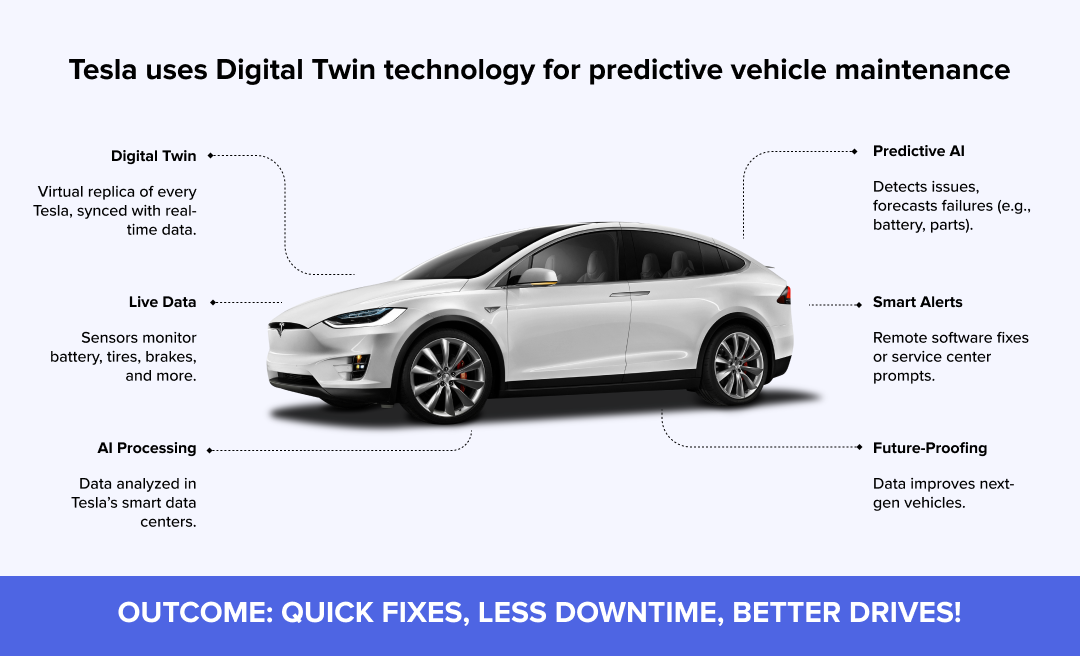
Tesla implements digital twin technology in its electric vehicles, continuously gathering sensor data to simulate real-world performance. This enables Tesla to deploy over-the-air (OTA) software updates, proactively addressing maintenance issues and optimizing vehicle efficiency without requiring in-person servicing.
GM’s AI-Powered Predictive Maintenance
AI-powered predictive maintenance uses machine learning and IoT sensors to analyze real-time vehicle data, identifying issues before they lead to costly repairs. Integrated into a car maintenance app, this technology helps prevent unexpected breakdowns, reduce maintenance expenses, and extend vehicle lifespan with proactive servicing.
General Motors (GM) utilizes OnStar Smart Driver, which continuously monitors engine performance, battery health, and tire pressure, sending predictive maintenance alerts to drivers. This helps them take preventive action, avoiding costly repairs and ensuring road safety.
Mercedes-Benz’s Utilization of AI Assistants for Vehicle Maintenance
AI-powered virtual assistants help drivers manage vehicle maintenance through interactive chat or voice-based support. These assistants provide real-time service reminders, troubleshooting guidance, and instant access to manuals, ensuring timely maintenance and improved vehicle health.
Mercedes-Benz USA introduced “Ask Mercedes”, an AI-driven chatbot that offers personalized assistance to vehicle owners. Users can ask maintenance-related questions, receive diagnostic insights, and get guided instructions for minor repairs through apps or smart speakers like Alexa and Google Assistant.
Regarding guided instruction, our experts at Appinventiv developed ActiDrive, a gesture-recognition app that enhances in-car interactions. Using advanced optical technology, ActiDrive lets drivers control the vehicle’s infotainment system touch-free, ensuring a safer and distraction-free driving experience.

Beyond convenience, it acts as a smart tracker—logging trips, remembering frequently traveled routes, and providing key insights such as time duration and distance covered.
Cost to Build a Vehicle Maintenance App
The cost to build a vehicle maintenance app depends on various factors, including app complexity, platform selection, UI/UX design, and feature set. Basic apps with service reminders are more affordable, while advanced versions integrating AI diagnostics and IoT tracking are costlier.
Additional expenses arise from security compliance, backend development, third-party integrations, and ongoing maintenance. Choice of cross-platform development frameworks, cloud storage, and API integrations further influence the overall budget.
Based on these factors, the overall vehicle maintenance app development cost ranges from $30,000 to $300,000 and may increase further depending on additional features and complexity.
The table below elaborates on the estimated cost to build a vehicle maintenance app:
| App Type | Features | Estimated Cost (USD) |
|---|---|---|
| Basic App | ✔ Service reminders ✔ Expense tracking ✔ Basic UI ✔ Single platform (iOS/Android) | $30,000 – $60,000 |
| Mid-Level App | ✔ Multi-vehicle support ✔ Cloud backup & data syncing ✔ Maintenance scheduling ✔ Roadside assistance ✔ Cross-platform support | $80,000 – $150,000 |
| Advanced AI/IoT-Powered App | ✔ AI-driven diagnostics ✔ OBD-II integration ✔ Predictive maintenance ✔ Telematics & GPS tracking ✔ Custom analytics dashboard ✔ IoT-enabled sensors | $150,000 – $300,000+ |
Here are a few cost-optimization tips to reduce the cost to build a vehicle maintenance app:
- Start with an MVP: Focus on essential features first and scale gradually.
- Opt for Cross-Platform Development: Saves time and costs using a single iOS and Android codebase.
- Leverage APIs: Integrate third-party diagnostics, payments, and tracking services instead of developing from scratch.
How to Monetize a Vehicle Maintenance App
A profitable vehicle maintenance app can leverage multiple revenue streams to enhance financial sustainability while delivering exceptional value to users. Here are the key business models for a vehicle maintenance app to explore for long-term success:
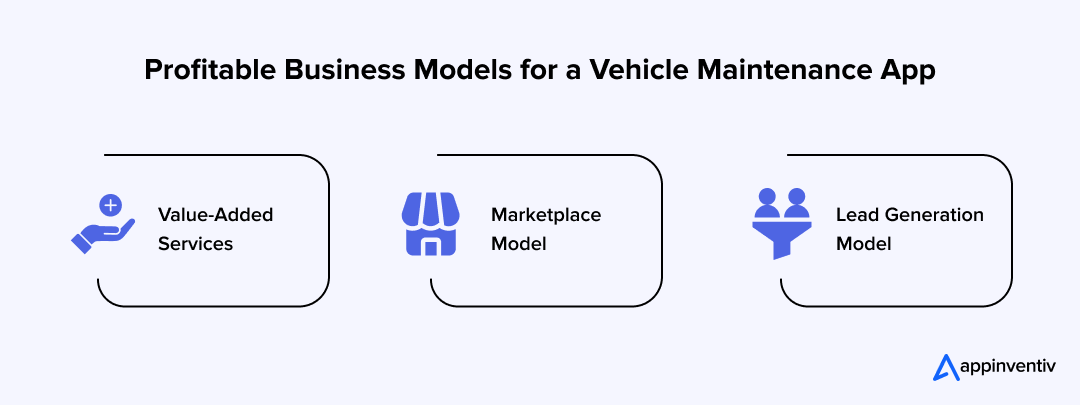
Value-Added Services
Enhances user experience by offering additional features that improve vehicle maintenance and safety.
- AI-Driven Predictive Maintenance: Sends automated alerts for servicing based on usage patterns.
- Roadside Assistance: Partners with towing services to provide emergency help.
- Insurance & Extended Warranties: Integrates with insurers to offer protection plans.
Marketplace Model
Facilitates direct transactions between users and service providers, ensuring seamless access to vehicle maintenance solutions.
- On-Demand Repair Services: Connects users with nearby mechanics and service centers.
- Spare Parts & Accessories Sales: Offers an in-app marketplace for purchasing vehicle parts and accessories.
- Subscription-Based Plans: Provide premium memberships with exclusive perks and discounts.
Lead Generation Model
Monetizes user traffic by connecting them with third-party service providers and relevant businesses.
- Affiliate Partnerships: Earns commissions from partner garages and dealerships.
- Sponsored Listings & Ads: Allows mechanics and auto shops to advertise within the app.
- Data Monetization: Provides anonymized insights to manufacturers and insurers.
Challenges to Build a Vehicle Maintenance App and Solutions to Overcome Those
Developing a robust vehicle maintenance app demands a strategic approach, incorporating the right technologies, seamless integrations, and a user-centric design. While challenges may arise, they can be effectively addressed with the right solutions, ensuring a scalable, secure, and high-performing application.
| Challenge | Solution |
|---|---|
| Ensuring Seamless Cross-Platform Compatibility | Utilize frameworks like React Native or Flutter to provide a unified experience across iOS and Android. |
| Handling Large-Scale Data Securely | Implement cloud-based storage, robust encryption, and ensure compliance with automotive data security standards. |
| Boosting User Adoption & Engagement | Design an intuitive UI/UX, enable personalized notifications, and incorporate gamification for improved user retention. |
| Real-Time Vehicle Diagnostics Integration | Leverage OBD-II, IoT sensors, and AI-driven analytics for accurate and efficient data processing. |
Future Trends in the Automotive Industry
The automotive industry is set to transform, driven by groundbreaking innovations and evolving mobility needs. Here are some key trends shaping its future:
- Rise of Hydrogen Fuel Cell Vehicles: While EVs dominate today, hydrogen-powered vehicles will emerge as a key solution for heavy-duty transport and long-haul logistics.
- Next-Gen Solid-State Batteries: Offering higher energy density, faster charging, and extended lifespan, these batteries will revolutionize EV efficiency and affordability.
- 5G-Enabled Connected Mobility: High-speed 5G networks will enhance vehicle-to-everything (V2X) communication, optimizing traffic flow, safety, and real-time navigation.
- Self-Healing & Adaptive Materials: Future vehicles will feature nanotechnology-based self-repairing paint, impact-resistant exteriors, and shape-shifting aerodynamic designs.
- Urban Air Mobility & Underground Transport: Concepts like Tesla’s Hyperloop and flying taxis from Uber and Joby Aviation could redefine future urban transportation.
- Autonomous Vehicles with Blockchain Security: Self-driving cars will integrate blockchain technology to ensure secure data exchange and enable decentralized ride-sharing.
Build a Powerful & Scalable Vehicle Maintenance App with Appinventiv
The future of vehicle maintenance lies in intelligent automation and predictive technology, where AI-driven diagnostics, IoT-enabled monitoring, and real-time data analytics revolutionize how vehicles are serviced. Advanced mobile app development services are at the core of this transformation, integrating cutting-edge features to create smarter, proactive, and fully automated maintenance solutions.
A feature-rich vehicle maintenance app enhances efficiency, minimizes downtime, and extends vehicle lifespan for individuals and fleet managers. By leveraging advanced digital solutions, businesses can deliver seamless and intelligent maintenance experiences, boosting customer satisfaction and operational efficiency.
As a leading automotive software development services provider, we, at Appinventiv, craft scalable, high-performance vehicle maintenance apps powered by AI, IoT, and cloud computing. Our expert-driven approach ensures a robust and future-ready solution for your business.
Let’s innovate together—partner with us today!
FAQs
Q. What are the benefits of a vehicle maintenance app?
A. A vehicle maintenance app empowers businesses with multiple benefits:
- Optimized fleet management
- Revenue growth opportunities
- Enhanced customer retention
- Data-driven decision making
- Operational automation
- Market differentiation
Q. What is the timeline to build a vehicle maintenance app?
A. The time required to build a vehicle maintenance app varies based on its complexity and feature set. A simple app with core functionalities can take 3 to 6 months, while a feature-rich solution with AI, IoT, and cloud integration may extend to 6 to 12 months or longer. A well-structured development approach and skilled professionals can help accelerate the timeline.
Q. What are the types of vehicle maintenance apps?
A. Here are some of the major types of apps for vehicle maintenance:
- Car maintenance app
- Truck maintenance app
- Auto maintenance app
- Bike maintenance app
- Fleet maintenance app
- Heavy-duty vehicle maintenance app
- Electric vehicle (EV) maintenance app
- On-demand fleet service app
- IoT-enabled fleet monitoring app
Q. How much does it cost to develop a vehicle maintenance app?
A. The overall vehicle maintenance app development cost varies between $30,000 to $300,000, depending on app complexity, features, platform selection, and third-party integrations. A basic version with core functionalities is more affordable, while an advanced app with AI diagnostics, IoT connectivity, and cloud-based analytics requires a higher investment. The cost may increase further based on additional customizations and feature enhancements.


- In just 2 mins you will get a response
- Your idea is 100% protected by our Non Disclosure Agreement.
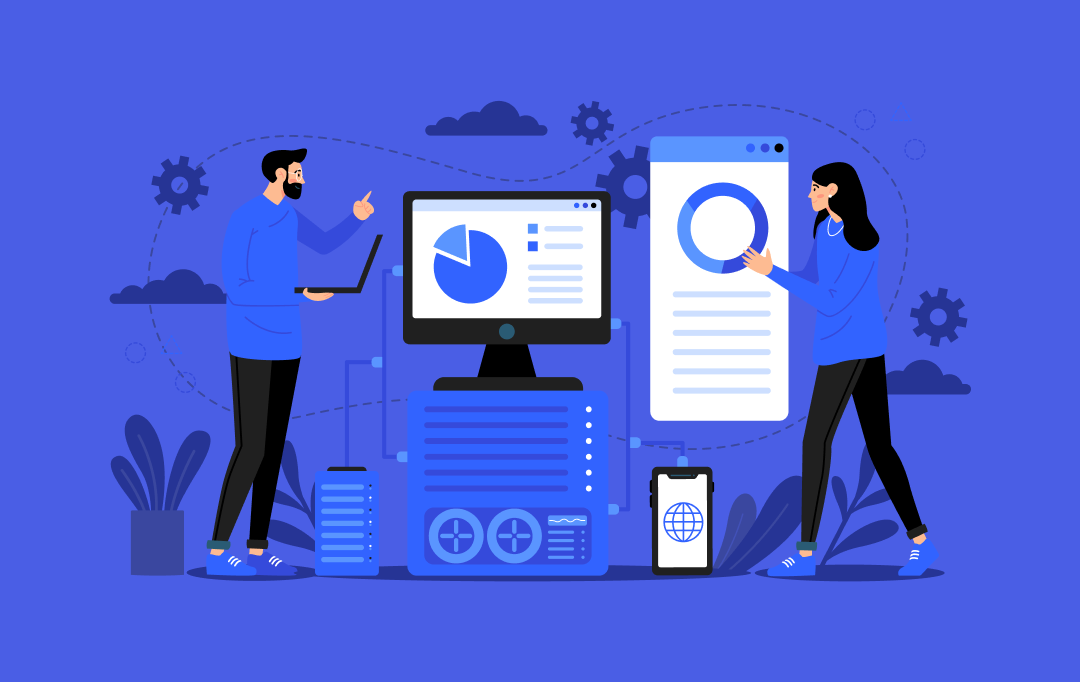
How Much Does It Cost to Build a White-Label Enterprise Procurement Software?
Key takeaways: The development of white-label enterprise procurement software typically costs between $50,000 and $500,000, depending on complexity and features. Key features include vendor management, budget tracking, purchase approvals, and invoice automation. Flexible monetization models - from modular licensing to integration fees- can future-proof revenue streams. Building a custom white-label solution gives you long-term control…

A Clear Breakdown of Custom Software Development Costs for Businesses in Canada
Key takeaways: Custom software in Canada typically ranges from CAD 55,00 to 550,000 ($40,000 to $400,000), depending on scope, integrations, and compliance. Costs rise in regulated sectors due to PHIPA, PCI DSS, AML rules, and strict Canadian data residency requirements. Planning, modular architecture, and cloud native services help control the software development cost in Canada…

The Real Cost of Building Professional Delivery Management Software
Key takeaways: Custom delivery management software has complete flexibility, scale, and integration, which conforms to the distinctive requirements of business. Fluid connection to ERP, CRM, and payment systems also introduces a large amount of complexity and additional cost, but is the key to efficiency. It is important to design scalable systems to grow in the…
